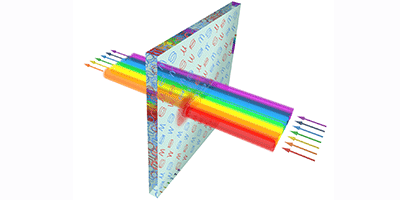The Helical Factor
Metamaterials are arguably best known as a potential basis for making cloaking devices. But the ability of these artificially engineered structures to respond to electromagnetic waves in many unusual ways makes them much more versatile than this one use would imply. Viktar Asadchy and colleagues from Aalto University in Finland and Gomel State University in Belarus have now designed and fabricated a thin metamaterial that absorbs electromagnetic waves over a narrow frequency band while producing no reflections at other frequencies. The device could find several applications, including perfect filters for electromagnetic waves and stealth technology.
Conventional absorbers provide efficient absorption of light in a given frequency range but also create an often-unwanted effect: they reflect—and so do not transmit perfectly—frequencies that fall outside the absorption frequency band. This partially blocked transmission generates shadows that render the absorbers detectable. Asadchy and colleagues’ metamaterial, however, absorbs waves of about 3 gigahertz and is both reflectionless and shadow-free in a very broad frequency range, from static fields to about gigahertz.
The researchers achieved this feat by creating an array of alternating right- and left-handed chromium–nickel helices, which they embedded in a plastic-foam slab. These structural elements have special electromagnetic features—they are equally strongly polarized electrically and magnetically—that confer the desired transmission, reflection, and absorption properties to the system. Interestingly, the device works for waves striking it on either or both of its faces. And although it operates in the microwave frequency band, the authors’ design concept is generic enough to be applied to other regions of the electromagnetic spectrum.
This research is published in Physical Review X.
–Ana Lopes





